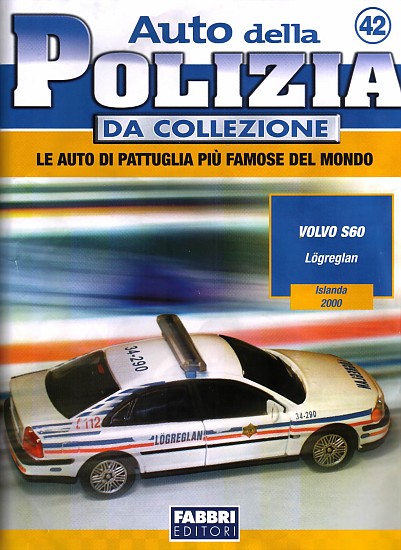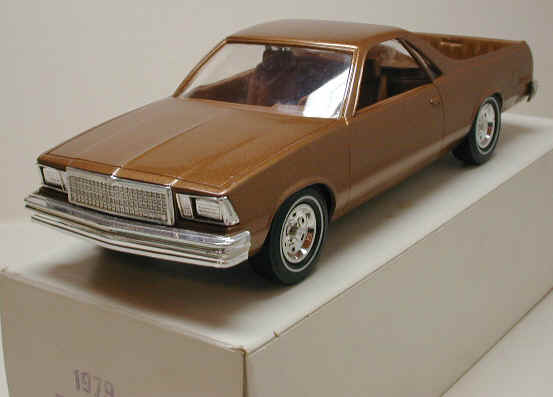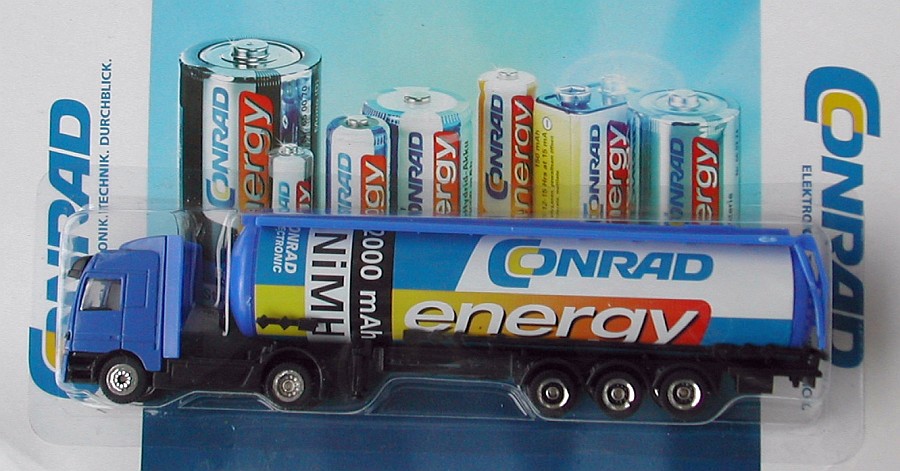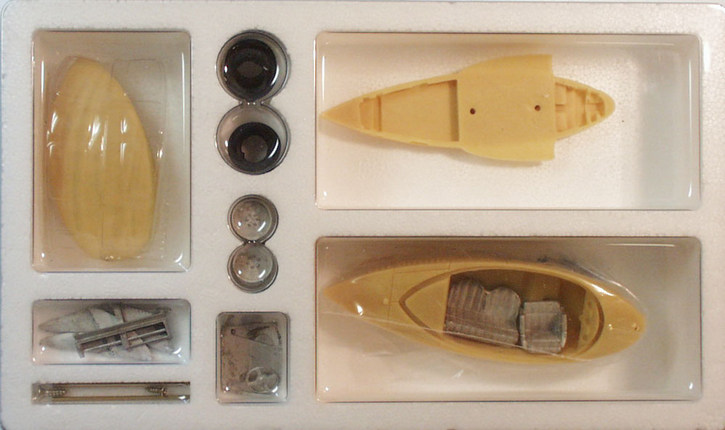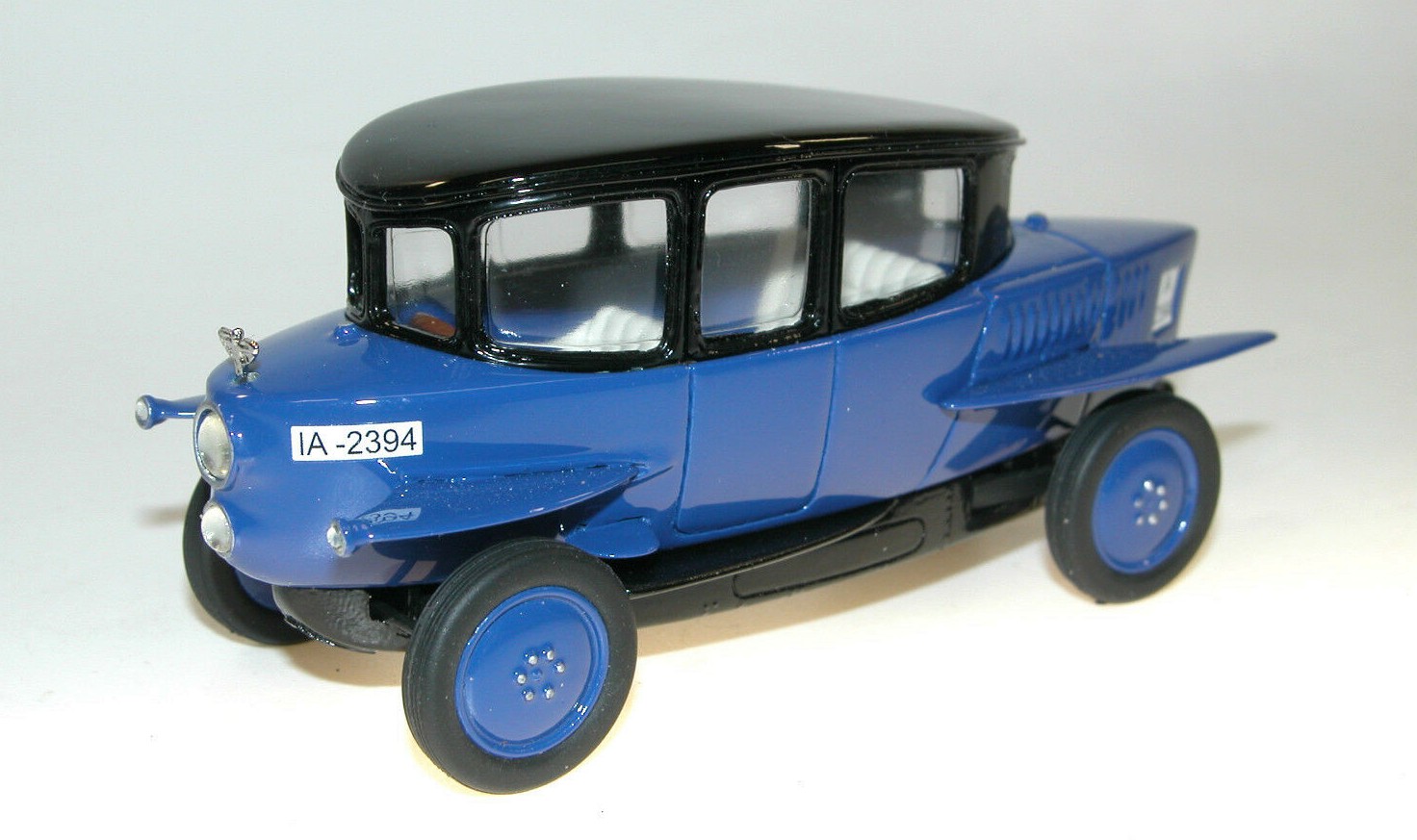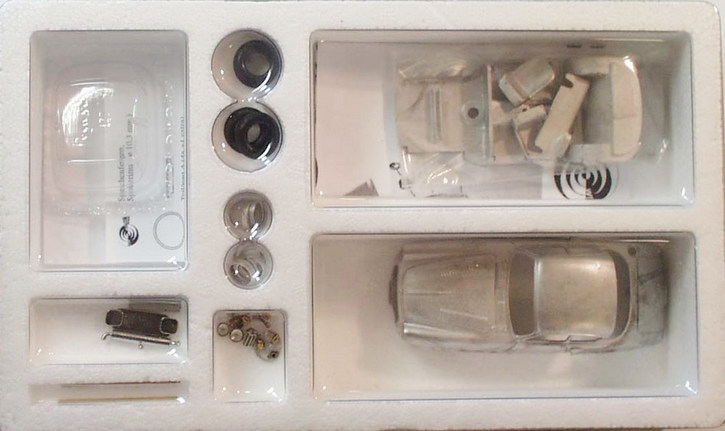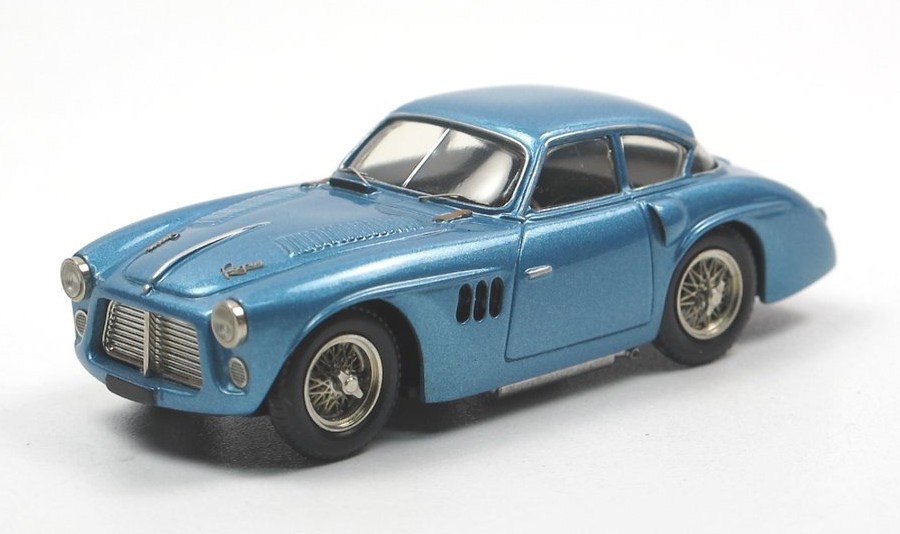Collecting from A to Z
A small glossary providing background information about model cars, useful hints, and definitions of special terms used by model car collectors.
The most important books, magazines, and internet resources used when creating this page can be found in the reference list.
Code system for special edition model cars, in the beginning mainly used for Matchbox models. A Code 1 model was totally built by the model car company itself, a Code 2 model was altered with permission of the maker and a Code 3 model was modified without permission.
Why are adult people (mostly men born before 1980) interested in model cars? Four typical reasons why someone has started collecting:
-
Nostalgia: Many collectors like models of cars they owned or admired when they were younger. Current manufacturers offer a wide range of models of classic cars, mostly from the 1950s to the 1980s, to meet this demand. The first diecast model ranges aimed at adult collectors in the 1960s and 1970s often focused on vehicles from the time before World War II.
-
Interest in technology and motoring history: For people interested in the history of the automobile, collecting model cars is a way to recall this history and to present it in three-dimensional form.
-
Admiration for craftsmanship: Collectors appreciate the accurate reproduction of proportions and details. They put model cars in display cases as decorative objects and even regard them as a kind of work of art. Furthermore, assembling model car kits with many details, as some collectors do themselves, is a creative hobby.
-
Exclusivity: As with other collectibles, collecting model cars is a way of acquiring rare and unique pieces. Searching for something unusual and finally owning it brings a certain pleasure.
Since many collectors enjoy having as complete a collection as possible, they focus on a particular theme and collect models of cars they particularly like. The theme is often a specific car brand, but particular car types or cars from a certain time period or from certain countries are also suitable collecting themes. The purpose of a vehicle can also define the theme of the collection: Extensive collections are possible on topics such as police cars or fire engines, taxis, tractors, racing cars from certain racing series or by certain drivers, and many other kinds of vehicles. A way of narrowing down a collection is to concentrate on a certain scale (the choice depends on the topic of the collection and the space available) or on certain model manufacturers. If you are not striving for completeness, however, you can simply buy the models you like and enjoy the diversity of model car production.
There are widely used terms to indicate whether a model is in good or bad shape. The most important of them are:
-
mint and boxed (MB): The model is in the original box, it is in excellent condition and looks like a new one. There is no damage on paint and small parts. Value: 100%.
-
mint (M): The model is in excellent condition as well, but the box is missing. Value: 50-80%.
-
near mint (NM): You can see that somebody played with the model. There are slight damages on paint (up to 2% of the painted surface), but no small parts are missing. Sometimes the chrome parts have lost their shine. Value: 40-50%.
-
slightly chipped (SC): larger, distinctive parts of the paintwork are scratched (up to 5%), small parts and decals may be damaged. But the model is complete, no parts are missing. Value: 25-40%.
-
almost trash: Missing parts, broken wheels, bended fenders - such models can only be used as providers of spare parts. Value: 0-25%.
The terms near mint & boxed (NMB), very slightly chipped (VSC; between NM and SC) and chipped (C) are quite common, too. Sometimes a rating ranging from C1 (very poor) to C10 (perfect) is also used to describe the condition of a model car.
Decal (short form of decalcomania) is the usual term for transfers as used in model making. Decals are produced by screen printing (higher quality) or thermal transfer printing and are used to apply lettering to a model that is too fine to be drawn on or painted. They must be moistened before being applied to the model, which activates the adhesive layer on which they are printed. Decals are thinner than stickers made of paper or plastic, the latter are usually only used on low-priced model cars. A modern alternative to decals in the industrial production of model cars is tampo printing.
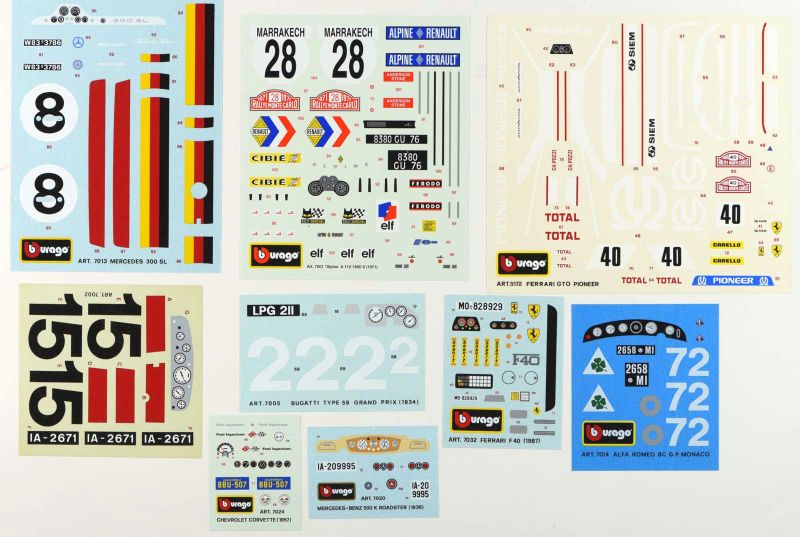
Mass-produced pressure cast ready made models. They are made of an alloy of zinc (predominating), magnesium and aluminium, sometimes with the addition of copper. The moulds are made of hard steel and very expensive. So producers of diecast models have to sell a high number of pieces of each model, otherwise they won't get enough profit. For the same reason, additional parts of diecast models are normally made of plastic in order to keep production costs low.
This problem has already occurred in the model car scene. For an individual or a small group of persons, it would normally be too costly and expensive to completely rebuild a detailed model car as a fake and to sell it with profit. However, since rare variants of models - especially from Matchbox and Bburago - were sold at very high prices among collectors in the 1990s, some people made money by changing paint or decals of cheaper variants and offering them as alleged rare "originals" at overpriced rates. The value of a faked model is zero.
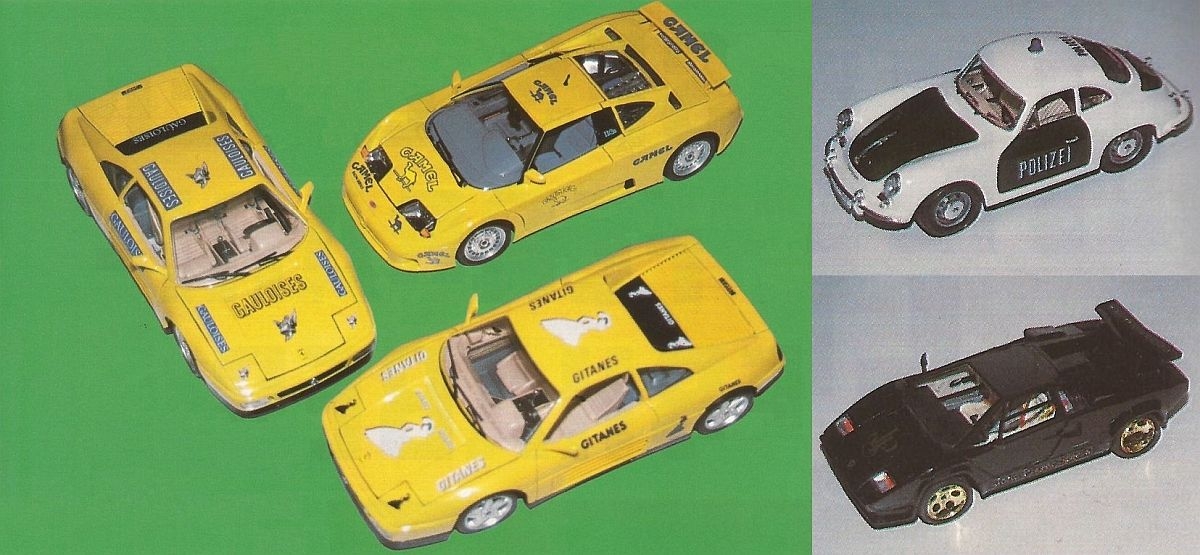
In most cases, repainted older Bburago models can be easily discovered. Since Bburago sprayed their models with doors, bonnet and luggage hood closed, there is only little paint on the body surface covered by the opening parts. This effect is very hard to imitate when the model is resprayed.
Experts often identify faked Matchbox Yesteryear models by manipulated rivets. Furthermore, some specialist retailers offer literature about Yesteryears that can be helpful in the evaluation of a rare model.
Faked early Yesteryear boxes made with colour photocopiers can often be identified by the wrong cardboard (too solid and much too bright on the inside), and while the dark surfaces on the original boxes are dark violet, on faked boxes they are often black.
Artisan-produced models intended exclusively for the collectors' market. They are made in limited numbers, usually from resin or white metal. By far the most common scale for handbuilt models is 1/43rd scale, but there are also models in 1/24th scale or larger, as well as in 1/76th scale or smaller. One of the first handbuilt models made of white metal in 1/43rd scale was the Ferrari 250 GTO from the Marc Europa series, produced in 1964 by Englishman Brian Jewell in about 100 items. Other English model makers such as John Day or Mike and Sue Richardson (Mikansue) were also among the pioneers in this field in the early 1970s. Manufacturers in France and Italy started production of handbuilt models soon afterwards.
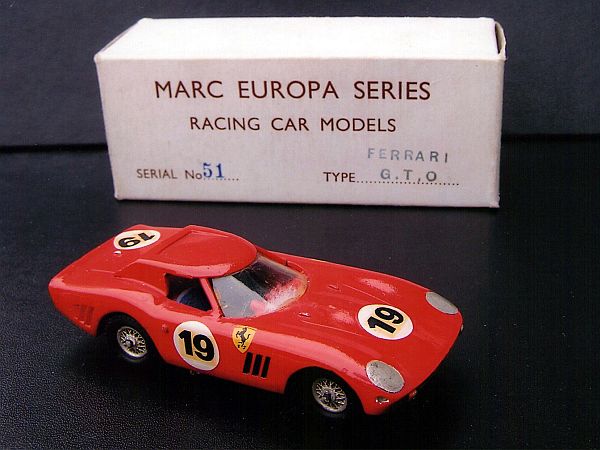
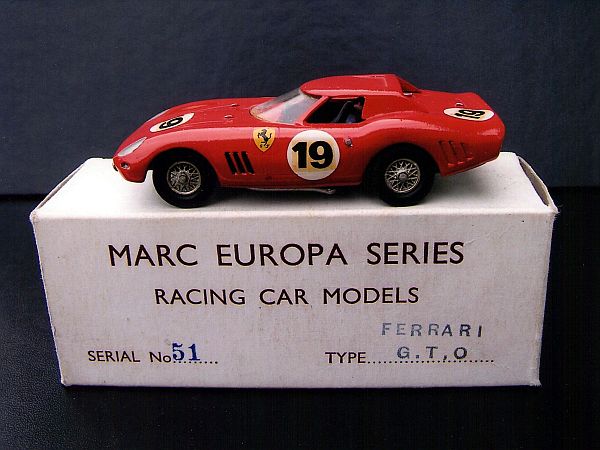
It may happen that diecast models get cracks caused by corrosion. Sometimes they break into pieces. The reason for this metal fatigue is bad quality of the diecast alloy. In most cases, models made before 1970 are concerned. Later, the manufacturers used better alloys. However, there are some exceptions - Russian model cars from the 1990s, and even some detailed Chinese-made models from the 1990s and 2000s, e.g. by Schuco, may also get metal fatigue. There is no cure for this kind of corrosion. But it is recommended to look for cracks when buying older models and to avoid extreme temperatures and sunlight.
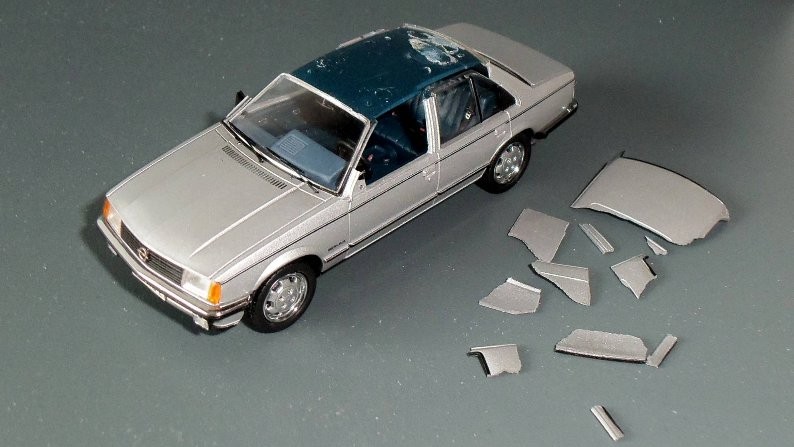
A fine and soft brush is the best tool to clean a dusty model. This method makes sure that small parts and decals are not damaged. Dirty models can be cleaned with a soft cloth. If they are very dirty, the cloth can be moistened with a few drops of lukewarm suds. Use q-tips to clean places which are difficult to reach. But never wipe over decals! The German company Momira has developped specialized cleaning systems for the cleaning of model cars, which obtain satisfying results according to test reports. However, model cars with delicate small parts are less suitable for such systems and must be handled with extreme care.
Partworks are periodical, mostly bi-weekly publications sold at newsagents or by subscription which include a collectors' item with each part of a series. There are several advantages of this way of distribution: First of all, it is a marketing strategy to bring collectors to buy a whole series of items, and in most cases the publishers offer special gifts to subscribers in order to make it particularly attractive to get all items. Secondly, the items can be sold at comparatively low prices because the lower VAT rates for print media are applicable: Officially only the magazine is sold and the collectors' item which is attached to the magazine is considered as a "free gift". Finally, selling collectors' items at newsagents instead of specialized shops can be a strategy to introduce new collectors to a hobby. The first issue of a partwork is usually sold at a loss-leader price, the second issue is already more expensive, and from the third issue, the regular price has to be paid.
Partworks have included all kinds of collectibles, e.g. movies on DVD, figurines, toys, and of course also model cars. The first partworks including model cars were released in the late 1990s and soon became particularly popular in France, Spain and Italy, later also in Eastern Europe and Latin America. In Northern Europe and other parts of the world, however, model car series sold at newsagents have remained quite rare. The most important publishers of partwork series thus come from the South-West of Europe: Altaya (in Spain and France), Del Prado and Salvat (in Spain), Hachette (in France), De Agostini, Fabbri and Centauria (in Italy). While these companies usually sell their partworks through newsagents, the French and Swiss publisher Atlas chose a different business model in various European countries by selling models per mail order directly to the customers, who had to subscribe to a series on a particular theme and to pay each model as it arrived. By the 2010s, De Agostini took over several competitors such as Altaya and Del Prado, and Hachette acquired Salvat, but the publishers still trade under their old names in their target market places.
Model car partworks deal with many different collection themes: road cars from a particular country or car make, police and fire vehicles, rally or racing cars, cars known from movies or comic strips, vans or tractors. One partwork usually consists of 30 to 80 different models, but there are partworks with more than 200 issues. On the other hand, some series are stopped after a few issues if they aren't successful. Most series include 1/43rd scale models, but models in other scales, even in 1/18th, have also been attached to magazines. Originally, the most important manufacturers of model cars for partwork series were Norev, Solido, Universal Hobbies and Premium & Collecting Trading Co. Ltd. (PCT, maker of the Ixo models), other models in partwork series have been made by Hongwell Cararama, Starline Models and other companies. In the 2010s, PCT became the predominating producer of partwork models worldwide. Many partworks include a mix of models from existing moulds and newly developped issues, some of them will be included later in the manufacturer's regular range. The partwork models are often slightly less detailed than the regular models from the same manufacturer (fewer decorations, plastic instead of photo-etched parts for details such as wire wheels or windscreen wipers, less detailed baseplates), but as they are much cheaper they might still be attractive for collectors.
Links to websites providing further information about partworks are available on my links page.
Sometimes small parts for details such as radiator grilles, wire wheels, door handles, window frames or windscreen wipers are photo-etched. The parts are drawn in a bigger scale and the pattern is scaled down and is copied photographically on fine sheet metal (steel, brass or nickel silver, 0.15 to 0.3 millimetres thick). Then the parts are etched in acid out of the metal. Using photo-etched parts allows to form better details, but the technology is expensive and was limited to handbuilt models for a long time. One of the pioneers, André-Marie Ruf from France, introduced photo-etched parts on his AMR models made of white metal in 1979. In the same year, Precision Miniatures from California started producing 1/43rd scale models with photo-etched wire wheels. Since the mid-1990s, mass-producers have applied photo-etched parts to their scale models for collectors, too.
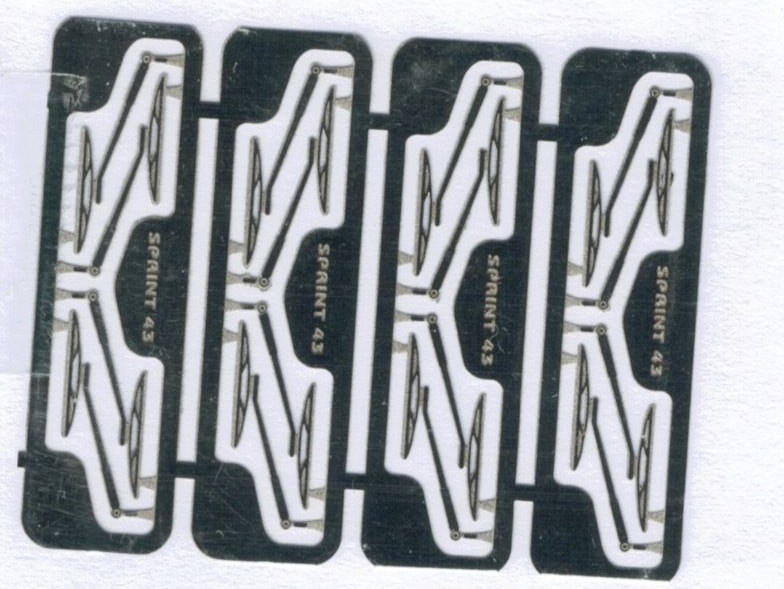
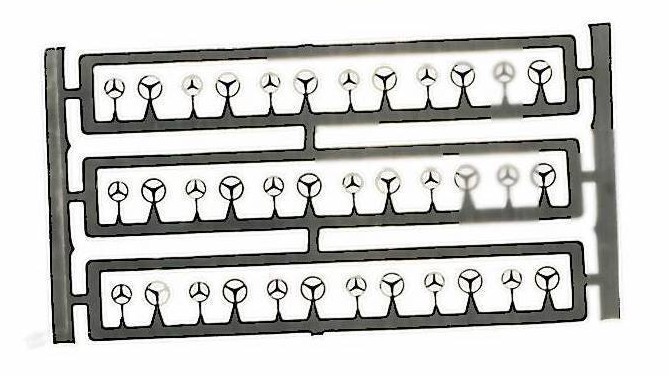
Models made for a customer, mostly not available in model shops. Promotionals are often used as a means of advertising by car companies - e.g. the 1/25th scale plastic promotional models made by manufacturers such as AMT, MPC and Jo-Han, and finally by Ertl and Brookfield Collectors Guild, from the late 1940s until the 1990s and available from the dealers of US car companies. Model vans and trucks with special printings advertising various products and brands are also popular.
Synthetic material used for handbuilt models. Two-part polyurethane (less often polyester) resin is cast in soft rubber moulds mostly lasting only 50 to 100 castings. Compared to white metal or diecast, this material allows the production of less expensive and more complicated castings, but only for a limited number of models.
Model cars in scales smaller than 1/87th are mostly only considered accessories for model railways. In Germany, models in 1/87th scale (matching with the H0-gauge model railway) are particularly popular (well-known manufacturers: Wiking, Herpa, Brekina, Rietze), but such models are also collected in other European countries and in North America. Models of cars in this scale are about 5 centimetres long. Mass-produced models in this size are usually made of plastic instead of diecast, because small details are easier and more precise to reproduce in plastic.
Many toy cars have been made in various rather small scales between 1/55th and 1/76th ("3 inch models", about 7.5 centimetres long: Matchbox, Hot Wheels, Siku, Majorette). Since the 1990s, various manufacturers have also introduced detailed diecast models for adult collectors in scales such as 1/64th (particularly popular in the USA and East Asia), 1/72nd, and 1/76th. Models in the latter scale are popular in the United Kingdom, since they match with the British 00-gauge model railways.
The most common scale all over the world is 1/43rd scale (length: about 10 centimetres). Models of this size match with the 0-gauge model railway, which was very popular in former times. Models of trucks, buses, and construction vehicles are often made in 1/50th scale.
Models in 1/35th or 1/36th scale (length: about 12 centimetres) were made by the British companies Corgi and Dinky Toys in the 1970s and 1980s. Mercedes-Benz sold promotionals in the same size, whereas 1/32nd scale - formerly a common size for model kits - is only important for slot racing cars and for models of agricultural vehicles today. A wide range of diecast toy cars with pull-back-action is also available in scales between 1/30th and 1/40th ("4.5 inch models").
In the 1970s and 1980s, 1/24th or 1/25th (length: about 18 centimetres) was popular for bigger scale models. This size is still important for plastic model kits, handbuilt models, and in the American market.
The success of model cars in 1/18th scale (length: about 25 centimetres) produced by the Italian manufacturer Bburago since the 1980s has induced many other brands to make models of the same size. In scales bigger than 1/18th, the offer of available models is not so wide; besides plastic kits and big toy cars, several detailed ready-made diecast and resin models for collectors have been released, notably in 1/12th scale (length: about 36 centimetres).
Spare parts for model cars can often be ordered directly from the manufacturer or from the distributor in your country. On the links page, there are links to the official websites of many model car manufacturers, a lot of these websites include some contact information. Addresses of model car distributors are regularly updated in model car magazines; in Switzerland, the most important distributors of model cars made by various manufacturers are Arwico and Tek-Hoby. Replica parts and spare tyres for obsolete model cars are sold by some specialized companies, e.g. MK Modelcarparts in the Netherlands.
A model car collector has got at least three problems: dust, sunlight and the question what to do with the model boxes.
Showcases provide some protection from dust. They can be bought in most furniture shops, but there are also some specialized shops, e.g. Adro, b+m Vitrinen, Presents Vitrinen, Vitrinenladen, Mancherlei-Vitrinen, and Sora.
Sunlight is another problem that mainly concerns plastic model cars: Heat and light may fade colours and distort plastic parts, so the models have to be protected from these elements.
Finally there is the problem with the boxes. It is strongly recommended to keep them because a box makes the model complete and increases its value (see condition). In addition, the original packaging is usually the safest place to store the model when it is not on display or when it has to be transported. For models without packaging, a cassette is suitable for transport, in which the interior can be partitioned into individual compartments for each model by means of dividers. Soft padding or filling material offers additional protection.
A good solution to store a large number of model cars in smaller scales (for which there was no place in a showcase) and their boxes could be cupboards with flat drawers as used for drawing paper or blueprints.
Tampo printing (also called pad printing or tampography) is an indirect gravure printing process. An elastic tampon is used to transfer ink from an etched printing plate (also known as a cliché or stereotype) onto a substrate. Multicolor applications can be executed by the coordinated use of several clichés. This method of printing allows to transfer a 2-D image on a 3-D object and became popularized in the 1970s with the advent of silicon. Silicon tampons are more practical, more consistent in hardness and surface texture, and last longer than their natural rubber predecessors. In the industrial production of model cars, tampo printing is widely used as an alternative to decals, as the resultant decorations are resistant to fading.
White metal models are made of pewter or a similar low temperature metal alloy consisting of tin, lead and antimony. They are heavier than diecast models of comparable size. The material is easier to process than diecast, as the melting point is lower and moulds made of hard rubber can be used instead of steel moulds. This makes it suitable for the manufacture of handbuilt models in small batches that would not be profitable in industrial production.

